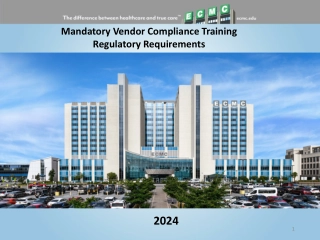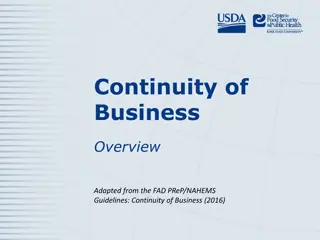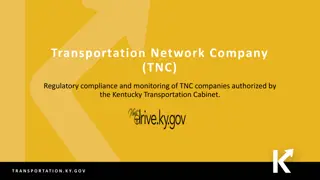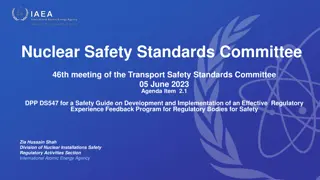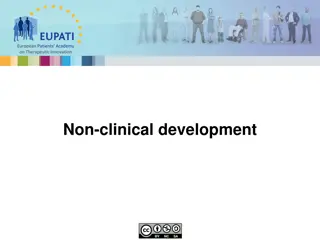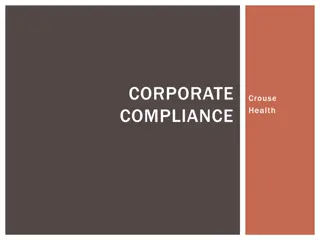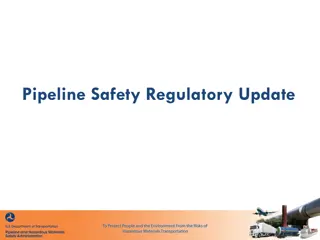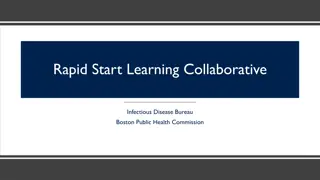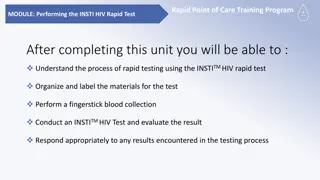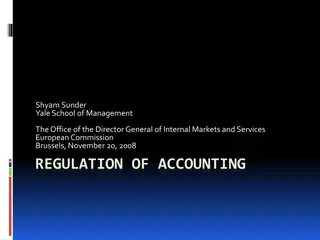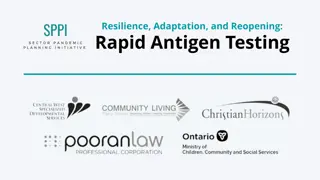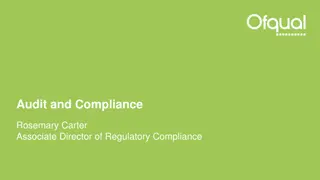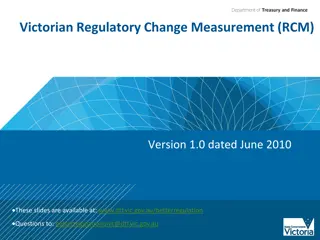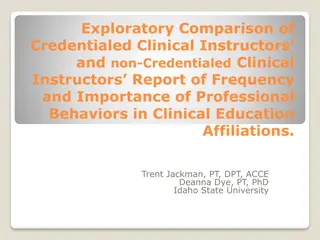Rapid Regulatory Compliance: Non-clinical Part I Overview
This course provides a rapid review on compliance, ethics, patient rights, and quality improvement in healthcare. Learn key laws, regulations, and ethical issues, understand patient rights, and explore quality improvement models. Discover how to report safety concerns and access compliance resources. Enhance your knowledge and stay updated on crucial aspects of patient care.
Download Presentation

Please find below an Image/Link to download the presentation.
The content on the website is provided AS IS for your information and personal use only. It may not be sold, licensed, or shared on other websites without obtaining consent from the author. Download presentation by click this link. If you encounter any issues during the download, it is possible that the publisher has removed the file from their server.
E N D
Presentation Transcript
Course Navigation Tips Use the buttons at the bottom of the course slides to adjust your viewing settings. It is recommended that you read the slides in full screen view. There is no audio for this course. Advance to the next slide when you finish reviewing this diagram. Adjusts or mutes audio. Full screen view Go to previous slide Go to next slide Toggle button: pause or play Slide number/total slides Slide play time
Welcome to Rapid Regulatory Compliance: Non-clinical Part I This course will rapidly review and update your knowledge of: Compliance and ethics Patient rights Patient care and protection Quality Improvement If you have concerns about any aspect of the safety or quality of patient care in your organization, be aware that you may report these concerns directly to Your subsidiary Compliance Officer The Corporate Compliance Hotline at 1-866-MHC-COMPly Your accrediting body (The Joint Commission)
Course Objectives After completing this review, you should be able to: 1. Cite key points of relevant laws and regulations for healthcare. 2. Define sexual harassment. 3. Cite key points related to patient rights. 4. Review the quality improvement model used throughout McLaren Health Care.
Course Outline Lesson 1 will focus on corporate compliance and ethical issues in healthcare. This includes laws and regulations, consequences of noncompliance, and features of a compliance program. Sexual harassment and McLaren as a Federal Contractor will also be discussed. Lesson 1: Corporate Compliance and Ethics Compliance laws and regulations Potential consequences of non- compliance Compliance programs Sexual Harassment Federal Contractors Lesson 2: Patient Rights Confidentiality Patient participation in treatment decisions Disclosure and Informed Consent Advance Directives Access to Emergency Services Respect, safety, and nondiscrimination Patient visitation rights Grievances Lesson 3: Quality Improvement Why it is important and what it is Our expectations The PDSA Cycle Lesson 2 will discuss patient rights, which include confidentiality, patient participation in treatment decisions, respect, safety and nondiscrimination, and patient visitation rights. Grievances will also be discussed. Patient confidentiality is discussed in the MHC HIPAA self-learning module. Lesson 3 will focus on quality improvement.
Lesson 1: Compliance and Ethics This lesson addresses: Corporate Compliance Sexual Harassment
Corporate Compliance: Introduction In recent years, government agencies have started to look more closely for healthcare fraud and misconduct. A lot of federal money has been used to investigate and prosecute suspected fraud. This has increased the number of providers convicted of fraud.
Corporate Compliance: Laws and Regulations Corporate compliance means following business laws and regulations. Applicable Laws and Regulations for healthcare include: Medicare Regulations Federal False Claims Act Stark Act Anti-Kickback Statute Sections of the Social Security Act Affordable Care Act Mail and Wire Fraud Statutes EMTALA HIPAA "Red Flags" Rule (Identity Theft Regulations) HIPAA and Red Flags Rule are covered in a separate McLaren Health Care e- Learning course. Let's take a closer look at the remaining laws and regulations.
Corporate Compliance: Laws and Regulations Let s first look at: Medicare Regulations Federal False Claims Act Stark Act
Medicare Regulations Any facility that participates in Medicare must follow Medicare Regulations. For example, facilities must: Meet standards for quality of care Not bill Medicare for unnecessary care Not bill Medicare for costs that are higher than the usual cost Follow other rules for claims and billing
Federal False Claims Act The False Claims Act makes it illegal to submit a falsified bill to a government agency. This act: Applies to healthcare because Medicare is a government agency. Allows a citizen who has evidence of fraud to sue on behalf of the government. This whistleblower is protected from retaliation for reporting the fraud. Note: State laws also focus on False claims in addition to the Federal False Claims Act.
Stark Act The Ethics in Patient Referrals Act (EPRA) is also called the Stark Act. This Act makes it illegal for physicians to refer patients to facilities or providers: If the physician has a financial relationship with the facility or provider If the physician s immediate family has a financial relationship with the facility or provider Note: This law does not apply in certain cases.
Corporate Compliance: Laws and Regulations Let's next look at: Anti-Kickback Statute Sections of the Social Security Act Mail and Wire Fraud Statutes Affordable Care Act
Anti-Kickback Statute The Medicare and Medicaid Patient Protection Act of 1987 is also called the Anti-Kickback Statute (AKBS). This act makes it illegal to give or take kickbacks, bribes, or rebates for healthcare that will be paid for by a government program. Note: This law does not apply in certain cases.
Sections of the Social Security Act The Social Security Act makes it illegal for hospitals to: Pay physicians to encourage them to limit services to Medicare or Medicaid patients. Offer gifts to Medicare or Medicaid patients to get their business.
Mail and Wire Fraud Statutes Mail and wire fraud statutes make it illegal to use the U. S. Mail or electronic communication as part of a fraud. For example, these statutes make it illegal to mail a fraudulent bill to Medicare.
Corporate Compliance: Laws and Regulations Finally, let's look at: EMTALA Note: HIPAA and the Red Flags Rule (medical identity theft) are covered in a separate McLaren Health Care specific self-learning module.
EMTALA The Emergency Medical Treatment and Active Labor Act (EMTALA) is also called the Patient Anti-Dumping Statute. This statute requires Medicare hospitals to provide emergency services to all patients, whether or not the patient can pay. Hospitals are required to: Screen all patients who come to the emergency room and determine whether or not they have an emergency condition. Stabilize patients who do have an emergency condition
Corporate Compliance: Potential Consequences of Noncompliance When a provider is convicted of breaking any of the laws for healthcare, penalties can include: Criminal fines Civil damages Jail time Exclusion from Medicare or other government programs In addition, a conviction can lead to serious public relations harm.
Corporate Compliance: Compliance Programs To help prevent misconduct, healthcare facilities have corporate compliance programs. A good compliance program reduces the risk of fraud. It does so by giving guidelines for how to do your job in an ethical and legal way. A copy of your facility's compliance program should be readily available to you. Ask your supervisor or compliance officer for more information.
Sexual Harassment Title VII of the Civil Rights Act of 1964 defines sexual harassment. This definition is summarized in the graphic to the right. Summary of Title VII Definition of Sexual Harassment Sexual harassment involves the following actions: Sexual advances, Requests for sexual favors, or Other conduct/communication of a sexual nature. When these actions are unwelcome and: Affect job status Interfere with work performance, or Create a hostile work environment To work toward eliminating sexual harassment in your facility: Be aware of the definition of sexual harassment. If you are a victim, confront the harasser directly, if you feel able to do so. Follow your facility's policies and procedures for reporting harassment.
Federal Laws Requiring Affirmative Action by Federal Contractors Hospitals are Federal Contractors if they: Have contracts with the federal government to provide health care to federal employees Provide health care services to active or retired military personnel under TRICARE Some McLaren subsidiaries are Federal Contractors, therefore, the entire MHC system is considered a Federal Contractor. Federal contractors must adhere to Federal laws requiring affirmative action: Executive Order 11246 prohibits discrimination against applicants and employees based on race, color, religion, sex, sexual orientation, gender identity, national origin The Rehabilitation Act prohibits discrimination based on mental and physical disabilities Vietnam Era Veterans Readjustment Assistance Act (VEVRAA) prohibits discrimination against protected veterans
Lesson 2: Patient Rights Topics to be discussed include: 1. Patient confidentiality 2. Patient participation in treatment decisions 3. Respect, safety, and nondiscrimination 4. Patient visitation rights 5. Grievances
Patient Rights: Confidentiality Patients have the right to privacy and confidentiality. Please refer to the MHC HIPAA self-learning module.
Participation in Treatment Decisions: Disclosure Patients have the right to: Patients have the right to know their: Participate in decisions about their care Set the course of their treatment Refuse treatment Diagnosis Prognosis Treatment Options To make informed decisions about treatment, patients must be given full and accurate information in a manner they can understand.
Respect, Safety, and Nondiscrimination: Respect Patients Patient s have the right to considerate, respectful and compassionate care. Respect means valuing the patient's: Needs Desires Feelings Ideas Healthcare providers must respect the patient's: Cultural and personal values, beliefs, and preferences Right to privacy Right to effective communication Right to pain management
Respect, Safety, and Nondiscrimination: Respect Into Action You should put your respect for patient rights into action by: Treating each patient in a respectful manner that supports his or her dignity Involving each patient in his or her care, treatment, and services Accommodating religious or other spiritual services Treat patients with common courtesy. For example: Knock and wait before entering a patient's room. Respond politely to patients. Listen to patients. Remain compassionate.
Respect, Safety, and Nondiscrimination: Safety Patients have the right to safety and security. Do your part to ensure a safe environment of care for your patients. Know your facility's policies for: Environmental safety Infection control Security Report to your supervisor immediately if: You think a patient may be victim of abuse A patient asks for protection from abuse Patients are vulnerable. You are responsible for their safety.
Respect, Safety, and Nondiscrimination: Nondiscrimination All patients have the right to fair and equal healthcare. This is true regardless of: Race Ethnicity National origin Religion Political affiliation Level of education Place of residence or business Age Gender Marital status Personal appearance Mental or physical disability Sexual orientation Genetic information Source of payment
Patient Visitation Rights A patient has the right to decide on who his or her visitors are, even if they are not related to the patient. Visitors may: Include spouses, domestic partners (same or opposite sex), family members, friends, or other support individuals the patient chooses Be restricted or limited for clinical or safety reasons, as described in the hospital s written policies Not be denied visiting privileges on the basis of race, color, national origin, sex, religion, age, sexual orientation, gender identity, or disability Have full and equal visitation privileges as consented to by the patient Be allowed to remain with the patient for emotional support during the hospital stay Include other patients, provided that they do not have infections that could endanger the patients whom they are visiting Your hospital should have written policies for visitors and for patients, and should inform the patient about the patient s rights to visitors, including any limitation and reasons for them.
Grievances Patients have the right to complain about the quality of their care. Common Causes of Complaints Waiting Times Operating Hours Conduct of Staff Many patient complaints can be addressed quickly. Adequacy of Staff When complaints cannot be resolved quickly and easily, patients have the right to file a grievance. A grievance is a formal complaint.
Grievances If a patient wants to file a grievance: Explain the grievance process at your organization. This includes the name of the staff person the patient should contact. Explain that grievances may be filed with state agencies. This is true whether or not the patient has already used the facility's internal grievance process. Give the patient the phone number and address for filing a grievance with the state.
Lesson 3: Quality Improvement Welcome to the lesson on quality improvement. This lesson covers: Why quality improvement is important What quality improvement is Our expectations The PDSA cycle
Why is Quality Improvement Important? Quality Improvement is not only a smart business practice, it is our mission to provide quality services. Mission Statement McLaren Health Care, through it s subsidiaries, will be the best value in healthcare as defined by quality outcomes and cost.
What is Quality Improvement? Continually improving organizational performance. A process aimed at achieving desired results. A step by step methodology for finding out what is needed to ensure good performance and then delivering it. An approach to process design that includes measurement, analysis, and sustained improvement. A system for continually improving what we do. Team-centered work toward a common, understood goal.
Our Expectation Our expectation is that we engage in ongoing improvement initiatives to achieve our mission. The process we use at McLaren Health Care is the IHI Model. IHI stands for Institute for Healthcare Improvement www.ihi.org
PDSA Cycle - The Foundation PLAN Make the plan! How will the change be implemented? DO Implement the plan, measuring progress as you go STUDY/CHECK Critically evaluate the results by asking: What went right? What went wrong? Why? ACT Adjust, Abandon, Adopt, Spread the Changes This cycle is repeated to build improvements upon successes!
Questions??? Contact your Subsidiary Compliance/HIPAA/Privacy/Security Officer!


